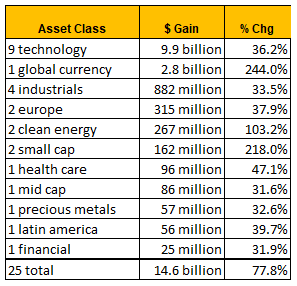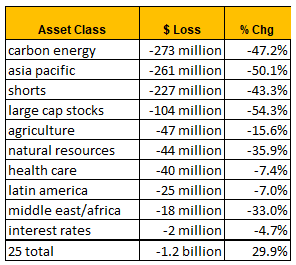During the annual Running of the Bulls in Pamplona, Spain, the bulls usually do not get hurt. They may bruise themselves if they slip and fall. But on the evening of the Bull Run, at 6:00 p.m., the bulls are killed during the Bullfights in the bullfight arena (Plaza de Toros).
For the bulls, it's a Fait Accompli - they're going to die, regardless of how much mayhem, pain, broken bones and the like they inflict on the poor souls who believe that this tradition somehow validates their manhood (have you seen any women in this annual fracas?) and their standing among friends and family. To me it's just plain weird. But I digress.
In the stock market, the bulls are under pressure, and they're on the run. Where do big institutional investors go when they're scared? United States Treasury bonds, that's where. The big money (not to be confused with the smart money) is offloading equity risk and seeking asylum in the safest paper on the planet - the U.S 10-yr Treasury note. If there really is such a thing as a "riskless" investment, it's the 10 yr note.
At least Uncle Sam is still offering a positive return on your money, which can't be said of European central banks who are offering negative rates. It's an upside-down financial world and nobody seems to have any ideas about how to get out of it.
What's a Bull To Do?
For those of you of the bullish persuasion, I'm told that you should do exactly nothing. The market will rally once more, taking us to never before dreamed-of heights in prices and prosperity.
For those of you of the cautious persuasion, it might not be the worst idea to take some risk off the table while this market tantrum runs its course.
What's up and what's down in this market, year-to-date?
Jim Cramer, bless his heart, says that "there's always a bull market somewhere." I think he's right about that. So I looked at the year-to-date performance of ETFs to get a sense of where the money is going. I'll provide a link to my full spreadsheet at the end of this article, but for now let's do a quick summary of what's going on beneath the headline numbers.
Winning and Losing asset classes year-to-date.
My methodology: Starting with the 1,000 largest ETFs available today, and eliminating those that were too small or too leveraged, I culled the top 25 and bottom 25 performers. The idea is to get a sense of where the big money is going and where it's leaving.
I ranked these ETFs by YTD returns and then gathered some intelligence about what's going on in our economy. These are breadcrumbs for you to follow and do your own due diligence. Here's what I found.
This first table groups each of the winning asset classes into one row. The big winner is technology, which shouldn't come as a surprise to those who have been paying attention.
The most profitable technology ETFs, and there were 9 of them in the top 25, gained an average of 36.2% YTD. Multiplied by the amount of money invested in these ETFs, we can say that they created $9.9 billion of wealth YTD. Not bad.
I'm not going to go through each asset class, but I do want to point out the runaway winner of all contestants - Bitcoin. After years in the doldrums, Bitcoin finally broke out this year and racked up a gain of 244%.
(As an aside, I bought several Bitcoins when they first came out, but then I used them to buy tulip bulbs from a guy in Amsterdam.) Anyway, congrats to you if you still have yours.
Now for the losers.
If you are a fan of energy stocks, I have good news and bad news for you. ETFs that invest in "clean energy" have had a great year so far. But the fossil dinosaurs are having a rough go. They were the bottom of the barrel in terms of YTD performance.
Asia (read: China) did poorly too. And you can go through the list at your own convenience.
The link below will take you to my original spreadsheet if you are inclined to dig deeper into the numbers. As always, feedback is encouraged even if you disagree with my assertions.


